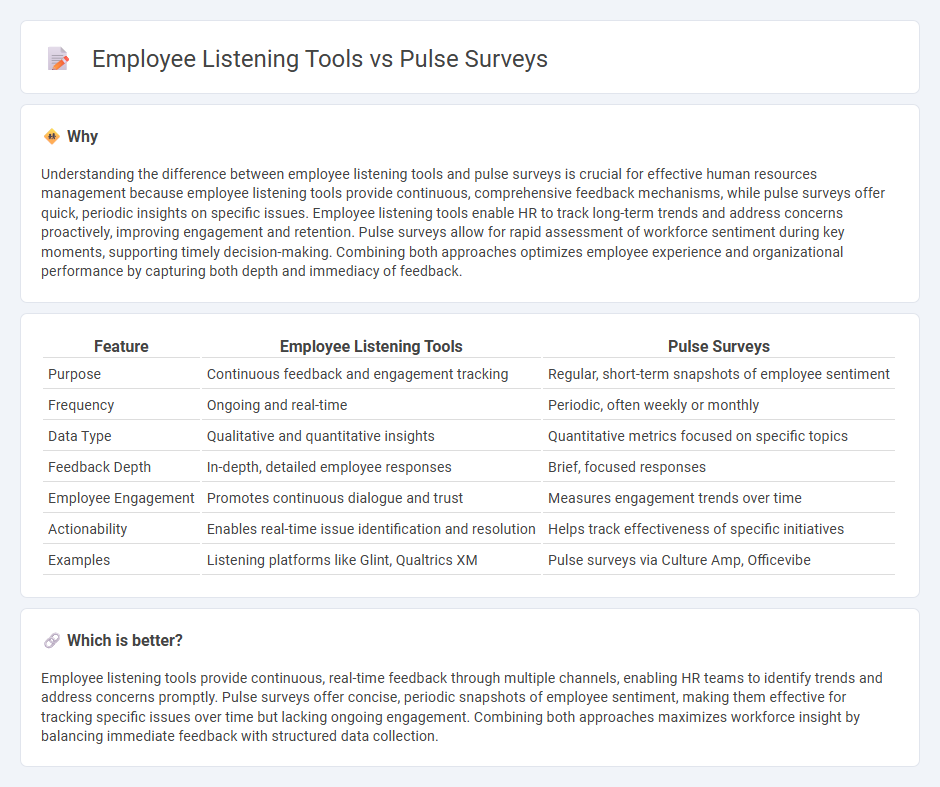
Employee listening tools provide continuous feedback channels that capture real-time sentiments and concerns, fostering a culture of open communication. Pulse surveys, typically brief and periodic, offer targeted snapshots of employee engagement and workplace climate, enabling quick identification of issues. Explore how integrating both approaches can enhance organizational responsiveness and employee satisfaction.
Why it is important
Understanding the difference between employee listening tools and pulse surveys is crucial for effective human resources management because employee listening tools provide continuous, comprehensive feedback mechanisms, while pulse surveys offer quick, periodic insights on specific issues. Employee listening tools enable HR to track long-term trends and address concerns proactively, improving engagement and retention. Pulse surveys allow for rapid assessment of workforce sentiment during key moments, supporting timely decision-making. Combining both approaches optimizes employee experience and organizational performance by capturing both depth and immediacy of feedback.
Comparison Table
| Feature | Employee Listening Tools | Pulse Surveys |
|---|---|---|
| Purpose | Continuous feedback and engagement tracking | Regular, short-term snapshots of employee sentiment |
| Frequency | Ongoing and real-time | Periodic, often weekly or monthly |
| Data Type | Qualitative and quantitative insights | Quantitative metrics focused on specific topics |
| Feedback Depth | In-depth, detailed employee responses | Brief, focused responses |
| Employee Engagement | Promotes continuous dialogue and trust | Measures engagement trends over time |
| Actionability | Enables real-time issue identification and resolution | Helps track effectiveness of specific initiatives |
| Examples | Listening platforms like Glint, Qualtrics XM | Pulse surveys via Culture Amp, Officevibe |
Which is better?
Employee listening tools provide continuous, real-time feedback through multiple channels, enabling HR teams to identify trends and address concerns promptly. Pulse surveys offer concise, periodic snapshots of employee sentiment, making them effective for tracking specific issues over time but lacking ongoing engagement. Combining both approaches maximizes workforce insight by balancing immediate feedback with structured data collection.
Connection
Employee listening tools and pulse surveys are interconnected as pulse surveys serve as a key method within employee listening platforms to capture real-time feedback on workplace sentiment. These tools utilize frequent, short surveys to gauge employee engagement, satisfaction, and concerns, enabling HR teams to identify trends and address issues proactively. Integrating pulse surveys within employee listening systems enhances data accuracy, fosters continuous communication, and supports strategic decision-making in human resources management.
Key Terms
Real-time feedback
Pulse surveys provide frequent, concise questions to capture employees' immediate sentiments, facilitating timely adjustments in workplace strategies. Employee listening tools encompass broader platforms integrating real-time feedback from multiple channels such as surveys, chatbots, and sentiment analysis to deliver continuous insight into employee experiences. Explore how combining these approaches can enhance organizational responsiveness and engagement.
Engagement measurement
Pulse surveys offer quick, frequent assessments of employee engagement through short, targeted questionnaires, capturing real-time sentiment. Employee listening tools provide a comprehensive approach by aggregating data from multiple channels such as surveys, feedback platforms, and sentiment analysis to identify engagement trends and underlying issues. Explore detailed comparisons to understand which method best drives meaningful employee engagement insights.
Continuous improvement
Pulse surveys deliver frequent, concise feedback to gauge employee engagement and satisfaction, enabling agile responses to workplace issues. Employee listening tools aggregate diverse feedback channels, such as surveys, social media, and direct comments, offering comprehensive insights for continuous improvement initiatives. Explore how integrating pulse surveys with employee listening platforms can enhance your organization's development strategies.
Source and External Links
What is a 'Pulse Survey'? - Pulse surveys are brief and regular questionnaires that check workforce sentiment and track engagement, focusing on specific topics and providing real-time insights.
Pulse Surveys: Questions, Use Cases + Free Templates - This resource provides guidance on creating pulse surveys, including best practices for crafting questions and leveraging them for organizational improvement.
Employee Pulse Surveys: The Complete Guide - This guide explains how pulse surveys are used to continuously gather feedback and measure sentiment within organizations through short, frequent check-ins.
 dowidth.com
dowidth.com